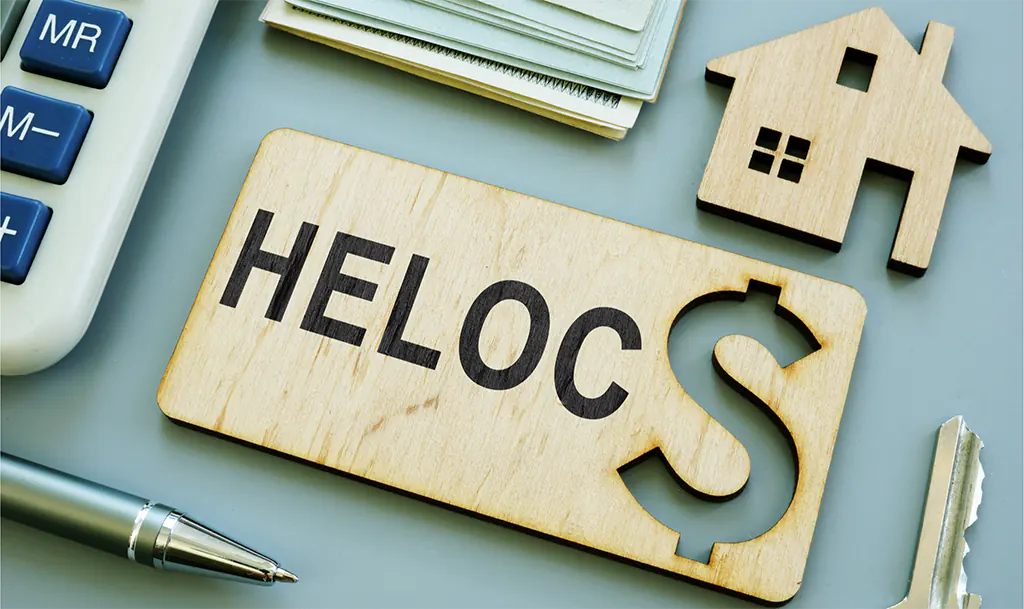UPDATED: April 22, 2022

If you have accumulated equity on your home, you might be able to convert it to cash. One way to accomplish that is with a home equity line of credit, or HELOC. The HELOC can be used for a range of projects: paying for a major kitchen remodel, eliminating high-interest credit card debt, or even helping to cover your children's college tuition.
Table of Contents
What Is Equity?
Equity on a home is the difference between what the homeowner owes on his or her mortgage and the home’s current worth. If $150,000 is owed on the mortgage loan and the home is now appraised at $200,000, then there is $50,000 of equity.
The equity can increase in two ways. As the homeowner pays down the mortgage, the amount of equity in the home will increase. Similarly, the equity will also grow if the value of the home increases.
However, the equity can fall if the home’s value drops at a rate faster than the speed at which the homeowner is paying down the mortgage’s principal balance.
FREE Mortgage/Refi Quotes Comparison
Compare Multiple Offers Instantly
How Does a Home Equity Line of Credit Work?
HELOCs are like credit cards. You must apply, and if approved, you receive a total credit line. The credit line is secured by the home’s equity, which means the value of your home is used as collateral for the line of credit. The HELOC revolving credit line can be used for large expenses or to consolidate higher-interest rate debt on other loans such as credit cards.
Once approved for a HELOC, you gain access to an account with the funds. Typically, you can write a check or use a debit card to borrow cash from those funds. And just like a credit card, the funds are paid back with interest. Therefore, you can choose to either make just the minimum payment or pay back what you borrowed that month in full.
As you repay your outstanding balance, the amount of available credit is replenished—much like a credit card. As a result, you can borrow against it again if necessary, and you can borrow as little or as much as you need throughout your draw period (typically 10 years) up to the credit limit established at the closing.
At the end of the draw period, the repayment period (typically 20 years) begins. A HELOC often has a lower interest rate than some other common types of loans, and the interest may be tax deductible. However, it is advisable to consult a tax advisor regarding interest deductibility as tax rules may have changed and vary by state.
Qualifying for a HELOC
First and foremost, qualifying for a HELOC requires available equity in your home; the amount you owe on your home must be less than its appraised value. Typically, banks and mortgage firms allow homeowners to borrow up to 85% of the value of the home minus the amount owed.
A lender generally examines a homeowner’s credit score and history, employment history, monthly income & expenses, similar to the procedures for obtaining the mortgage. Whether you can qualify for a HELOC, the interest rate you receive and the total credit limit depends quite a bit on your credit score, as well as other financial factors.
When applying for a HELOC, it is also important to ask your lender if there are any fees associated with it. There may be up-front fees, such as an application fee, an annual fee and a cancellation or early closure fee.
Variable Interest Rate
With a variable interest rate on a home equity line of credit, the rate can fluctuate from month to month. The variable rate is calculated from both an index and a margin.
An index is a financial indicator used by banks to set rates on many consumer loan products. Most banks use the U.S. Prime Rate as published in The Wall Street Journal as the index for HELOCs. The index, and consequently the HELOC interest rate, can rise or decline. The other component of a variable interest rate is a margin, which is added to the index. The margin is constant throughout the life of the line of credit.
As the borrower withdraws money from a HELOC, he or she will get monthly bills with minimum payments that may be interest-only, or interest plus principle (depending of the details of the credit line). Payments may change based on your balance and interest rate fluctuations, and may also change if you make additional principal payments. If you can make additional principal payments it will help you save on the interest you are charged and help you reduce your overall debt more quickly.
Fixed Interest Rate Option
Some lenders offer an option that allows you to convert a portion of the outstanding variable-rate balance on your HELOC to a fixed rate. Payments you make on a balance at a fixed interest rate are predictable and stable and can protect you from rising interest rates.
HELOCs vs Home Equity Loan
HELOCs and a home equity loan both utilize the home as collateral, but they are different. A home equity loan is an installment loan, like a mortgage or car loan. You borrow a certain amount of money and make a fixed payment for a set period of time to pay it back. While the home equity line of credit is a revolving account, similar to a credit card.
The Benefits and Disadvantages of HELOCs
It’s important to understand the pros and cons to decide if obtaining a HELOC is a good financial move. Here is a quick look at some of the positives and negatives.
Advantages
Flexibility. The homeowner decides when and how to use the funds, and can draw from the credit line at any time. As long as you make minimum payments, you can also manage how you pay the debt off. That makes a HELOC more flexible than a home equity loan, which locks the borrower into a specific monthly payment.
Lower interest rates. In many cases, HELOCs have lower interest rates than other types of credit. That is because they are secured by the home’s value, so there is less risk for the lender. They can be used to pay off higher-interest debt or to fund a large purchase without a higher-interest loan.
Tax-deductible interest. Some or all of the interest paid on your HELOC debt can be tax deductible. That can help lower the borrower’s tax burden on April 15.
Disadvantages
Diminished equity. The more you draw funds from the HELOC, the lower the equity in your home will be. In other words, using your credit line means you owe more on your home—maybe even as much as the home is worth.
The HELOC is tied to your home ownership. If you default on minimum payments, you could lose your home to foreclosure. That is true even if your original mortgage is in good standing.
Temptation to overspend. Some HELOCs can provide lines of credit that are much bigger than the average credit limit offered by credit cards. That access to cash can make it tempting to make big purchases that could possibly exceed your means—and unfortunately, you will eventually have to pay for all those purchases. If money management is not your strong suit, a HELOC could lead to a large accumulation of debt.
Alternatives to Home Equity Lines of Credit
HELOCs can be a great way to access cash for emergency needs or big purchases, but might not be right for everyone. Plus, a homeowner must have home equity to apply. As a result, if you are not a homeowner, its not an option.
If you prefer a more traditional option or do not have home equity, here are a few other options to consider:
Personal loans. Personal loans can be used for a variety of expenses. Lenders typically analyze your credit history and income before approving your personal loan.
Mortgage refinancing. Refinancing your mortgage at a lower rate or longer terms can help reduce how much you pay each month. That can help you stabilize cash flow or use your income for other needs. When taking cash out, this is called a cash-out refi.
Credit cards. Credit cards can be a way to cover immediate expenses, especially if you are approved for a card with a 0% introductory annual percentage rate (APR) offer. These offers enable the card holder to make purchases and pay them off without any interest during the introductory offer.
FREE Mortgage/Refi Quotes Comparison
Compare Multiple Offers Instantly






Leave a Reply